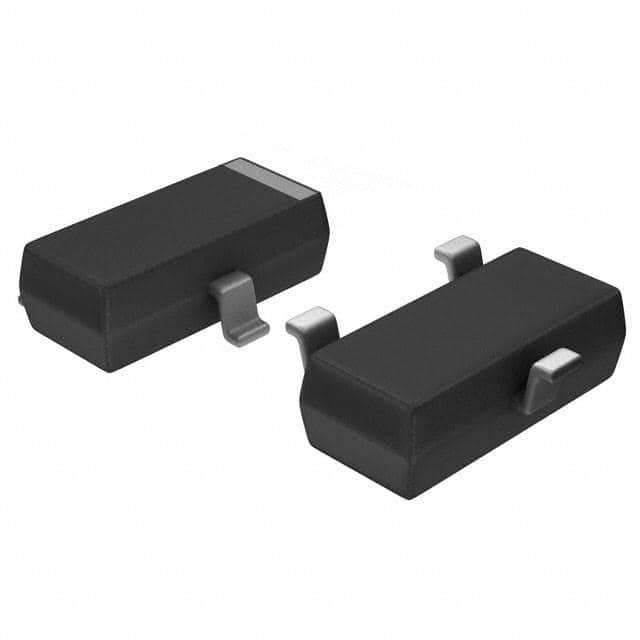BAS70-TP: Diode Product Overview
Introduction
The BAS70-TP diode belongs to the category of small signal Schottky diodes and is commonly used in various electronic applications. This entry provides a comprehensive overview of the BAS70-TP diode, including its basic information, specifications, pin configuration, functional features, advantages and disadvantages, working principles, application field plans, and alternative models.
Basic Information Overview
- Category: Small Signal Schottky Diode
- Use: Rectification, clamping, protection, and switching in electronic circuits
- Characteristics: Low forward voltage drop, fast switching speed, low leakage current
- Package: SOD-323 (SC-76)
- Essence: High-performance diode for small signal applications
- Packaging/Quantity: Available in tape and reel packaging with varying quantities
Specifications
- Forward Voltage: 0.32V at 1mA
- Reverse Voltage: 70V
- Maximum Continuous Forward Current: 200mA
- Reverse Recovery Time: 4ns
- Operating Temperature Range: -65°C to 125°C
Detailed Pin Configuration
The BAS70-TP diode has a standard SOD-323 (SC-76) package with two pins. The pin configuration is as follows: - Pin 1: Anode - Pin 2: Cathode
Functional Features
- Fast Switching Speed: Enables rapid response in electronic circuits
- Low Forward Voltage Drop: Minimizes power loss and heat generation
- Low Leakage Current: Ensures efficient performance in low-power applications
Advantages and Disadvantages
Advantages
- High-Speed Operation: Suitable for high-frequency applications
- Compact Package: Ideal for space-constrained designs
- Low Power Dissipation: Enhances energy efficiency in circuits
Disadvantages
- Limited Reverse Voltage: Unsuitable for high-voltage applications
- Sensitivity to Overvoltage: Requires additional protection in certain circuits
Working Principles
The BAS70-TP diode operates based on the Schottky barrier principle, where the metal-semiconductor junction allows for fast switching and low forward voltage drop. When forward-biased, it conducts current with minimal voltage drop, making it suitable for rectification and switching applications.
Detailed Application Field Plans
The BAS70-TP diode finds extensive use in the following application fields: - Signal Demodulation: Extracting modulated signals from carrier waves - Voltage Clamping: Protecting sensitive components from voltage spikes - Signal Mixing: Blending multiple input signals in communication systems - Low-Power Switching: Controlling low-current circuits efficiently
Detailed and Complete Alternative Models
Several alternative models to the BAS70-TP diode include: - BAT54C: Similar characteristics with different package options - BAV99: Dual diode configuration for more complex circuit requirements - 1N5819: Higher reverse voltage capability for increased protection
In conclusion, the BAS70-TP diode offers high-performance characteristics in a compact package, making it suitable for various small signal applications. Its fast switching speed, low forward voltage drop, and low leakage current make it an essential component in modern electronic designs.
Word Count: 443
قم بإدراج 10 أسئلة وإجابات شائعة تتعلق بتطبيق BAS70-TP في الحلول التقنية
What is BAS70-TP?
- BAS70-TP is a high-speed switching diode array commonly used in electronic circuits for applications such as signal demodulation, signal clamping, and voltage steering.
What are the key features of BAS70-TP?
- BAS70-TP features low forward voltage drop, fast switching speed, and high reverse breakdown voltage, making it suitable for high-frequency and high-speed applications.
What are the typical applications of BAS70-TP?
- BAS70-TP is commonly used in RF and microwave applications, mixers, detectors, and high-speed switching circuits due to its fast recovery time and low capacitance.
What is the maximum forward voltage of BAS70-TP?
- The maximum forward voltage of BAS70-TP is typically around 0.715V at a forward current of 100mA.
What is the reverse breakdown voltage of BAS70-TP?
- The reverse breakdown voltage of BAS70-TP is typically around 70V, making it suitable for use in circuits with higher reverse voltages.
What is the typical capacitance of BAS70-TP?
- The typical capacitance of BAS70-TP is around 2pF, which is beneficial for high-frequency applications where low capacitance is desired.
Can BAS70-TP be used in rectifier applications?
- Yes, BAS70-TP can be used in low-power rectifier applications due to its low forward voltage drop and fast recovery time.
What is the operating temperature range of BAS70-TP?
- BAS70-TP is typically rated for operation within a temperature range of -65°C to 125°C, making it suitable for a wide range of environments.
Is BAS70-TP RoHS compliant?
- Yes, BAS70-TP is compliant with the Restriction of Hazardous Substances (RoHS) directive, making it environmentally friendly and suitable for use in various electronic products.
Where can I find detailed technical specifications for BAS70-TP?
- Detailed technical specifications for BAS70-TP can be found in the datasheet provided by the manufacturer or distributor, which includes information on electrical characteristics, packaging, and recommended operating conditions.


